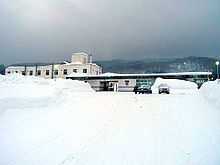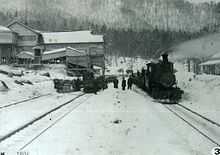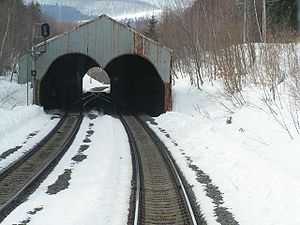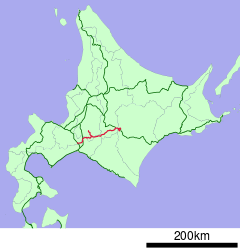Sekishō Line
| Sekishō Line | |||
|---|---|---|---|
|
A snow shelter protecting railway switches from possible freezing, at Nishi-Shintoku Junction | |||
| Overview | |||
| Type | Heavy rail | ||
| Locale | Hokkaido | ||
| Termini |
Minami-Chitose Shintoku | ||
| Stations | 15 | ||
| Operation | |||
| Owner | JR Hokkaido | ||
| Technical | |||
| Line length | 132.4 km (82.3 mi) (main line) | ||
| Track gauge | 1,067 mm (3 ft 6 in) | ||
| |||

The Sekishō Line (石勝線 Sekishō-sen) is a railway line in Japan operated by Hokkaido Railway Company (JR Hokkaido). The main Sekishō Line connects Minami-Chitose in Chitose and Shintoku Station in the town of Shintoku. A branch line connects Shin-Yūbari to Yūbari. The name of the line comes from the subprefectures along the route, namely Ishikari (石狩) and Tokachi (十勝).
Basic data
- Distances
- Main line, Minami-Chitose - Shintoku: 132.4 km
- Branch line, Shin-Yūbari - Yūbari: 16.1 km
- Operators
- Hokkaido Railway Company (category 1)
- Minami-Chitose - Shintoku: 132.4 km
- Shin-Yūbari - Yūbari: 16.1 km
- Japan Freight Railway Company (category 2)
- Minami-Chitose - Kami-Ochiai Junction: 108.3 km
- Hokkaido Railway Company (category 1)
- Track: single
- Block system:
- Minami-Chitose - Shintoku: Automatic
- Shin-Yūbari - Yūbari: Special Automatic (track circuit detection); simplified automatic system
Services
The line is a part of the main line between Sapporo and eastern Hokkaido. Super Ōzora limited express trains run between Sapporo and Kushiro 7 times a day, while Super Tokachi runs twice daily, Tokachi 4 times daily, both between Sapporo and Obihiro. The Marimo sleeping car service which formerly operated between Sapporo and Kushiro, was discontinued in 2008.
There are no local train services between Shin-Yūbari and Shintoku, since the line runs through practically unpopulated areas. There is a local train service between Minami-Chitose and Yūbari (via Shin-Yūbari), with one train approximately every 2 hours.
Stations
| Station | Distance (km) | Transfers | Location | ||
|---|---|---|---|---|---|
| Main Line | |||||
| H14 | Minami-Chitose | 南千歳 | 0.0 | Chitose Line (■ Main Line, ■ Shin-Chitosekūkō Branch Line) | Chitose |
| Komasato Passing Loop | 駒里(信) | 5.4 | |||
| Nishi-Hayakita Passing Loop | 西早来(信) | 11.7 | Abira, Yūfutsu | ||
| K15 | Oiwake | 追分 | 17.6 | Muroran Main Line | |
| K16 | Higashi-Oiwake | 東追分 | 21.6 | ||
| K17 | Kawabata | 川端 | 27.0 | Yuni, Yūbari | |
| Takinoshita Passing Loop | 滝ノ下(信) | 30.3 | Kuriyama, Yūbari | ||
| K18 | Takinoue | 滝ノ上 | 35.8 | Yūbari | |
| K19 | Tomisato | 十三里 | 40.2 | ||
| K20 | Shin-Yūbari | 新夕張 | 43.0 | ■ Sekishō Line (Yūbari Branch Line) | |
| Kaede Passing Loop | 楓(信) | 48.7 | |||
| Osawa Passing Loop | オサワ(信) | 55.7 | Mukawa, Yūfutsu | ||
| Higashi-Osawa Passing Loop | 東オサワ(信) | 59.6 | |||
| Seifūzan Passing Loop | 清風山(信) | 67.3 | Shimukappu, Yūfutsu | ||
| K21 | Shimukappu | 占冠 | 77.3 | ||
| Higashi-Shimukappu Passing Loop | 東占冠(信) | 81.3 | |||
| Takinosawa Signal Passing Loop | 滝ノ沢(信) | 85.7 | |||
| Horoka Passing Loop | ホロカ(信) | 92.6 | |||
| K22 | Tomamu | トマム | 98.6 | ||
| Kushinai Passing Loop | 串内(信) | 104.2 | Minamifurano, Sorachi | ||
| Kami-Ochiai Junction | 上落合(信) | 108.3 | |||
| Shin-Karikachi Passing Loop | 新狩勝(信) | 113.9 | Shintoku, Kamikawa | ||
| Hirouchi Passing Loop | 広内(信) | 120.1 | |||
| Nishi-Shintoku Passing Loop | 西新得(信) | 125.6 | |||
| K23 | Shintoku | 新得 | 132.4 | ■ Nemuro Main Line | |
| Yūbari Branch Line | |||||
| K20 | Shin-Yūbari | 新夕張 | 0.0 | ■ Sekishō Line (Main Line) | Yūbari |
| Y21 | Numanosawa | 沼ノ沢 | 2.7 | ||
| Y22 | Minami-Shimizusawa | 南清水沢 | 6.7 | ||
| Y23 | Shimizusawa | 清水沢 | 8.2 | ||
| Y24 | Shikanotani | 鹿ノ谷 | 14.8 | ||
| Y25 | Yūbari | 夕張 | 16.1 | ||
Passing loops and junctions
(upper left) Nemuro Main Line (for Furano)
(lower left) Sekishō Line
(right) Nemuro Main Line for Obihiro and Kushiro
Shin-Karikachi Tunnel in red
Kami-Ochiai Junction
43°6′8″N 142°41′31″E / 43.10222°N 142.69194°E
Kami-Ochiai Junction (上落合信号場 Kami-Ochiai Shingōjō) is a junction in Minamifurano, Sorachi. This junction is located in Shin-Karikachi Tunnel (新狩勝トンネル) (near the western mouth).
Passing Loops between Minami-Chitose and Kami-Ochiai Junction
Komasato Passing Loop
42°48′13″N 141°44′04″E / 42.80361°N 141.73444°E
Komasato Passing Loop (駒里信号場 Komasato Shingōjō) is a passing loop in Chitose, Hokkaidō with two tracks and two snow shelters.
Nishi-Hayakita Passing Loop
42°49′28″N 141°48′18″E / 42.82457°N 141.80492°E
Nishi-Hayakita Passing Loop (西早来信号場 Nishi-Hayakita Shingōjō) is a passing loop in Abira, Hokkaidō with two tracks and two snow shelters (one of them is connected to a tunnel).
Takinoshita Passing Loop
42°54′26″N 141°55′20″E / 42.90711°N 141.92219°E
Takinoshita Passing Loop (滝ノ下信号場 Takinoshita Shingōjō) is a passing loop in Kuriyama, Hokkaidō with two tracks and two snow shelters.
Kaede Passing Loop
42°55′54″N 142°05′30″E / 42.93176°N 142.09153°E
Kaede Passing Loop (楓信号場 Kaede Shingōjō) is a passing loop in Yūbari, Hokkaidō with two tracks and two snow shelters. It was Kaede Station before 12 March 1994.
Osawa Passing Loop
42°56′01″N 142°10′34″E / 42.93360°N 142.17600°E
Osawa Passing Loop (オサワ信号場 Osawa Shingōjō) is a passing loop in Mukawa, Hokkaidō with two tracks and two snow shelters.
Higashi-Osawa Passing Loop
42°56′37″N 142°13′10″E / 42.94370°N 142.21939°E
Higashi-Osawa Passing Loop (東オサワ信号場 Higashi-Osawa Shingōjō) is a passing loop in Mukawa with two tracks and two snow shelters.
Seifūzan Passing Loop
42°57′00″N 142°18′29″E / 42.95000°N 142.30803°E
Seifūzan Passing Loop (清風山信号場 Seifūzan Shingōjō) is a passing loop in Shimukappu, Hokkaidō with two tracks and two snow shelters.
Onitōge Passing Loop
42°58′25″N 142°20′25″E / 42.97370°N 142.34022°E
Onitōge Passing Loop (鬼峠信号場 Onitōge Shingōjō) was a passing loop in Shimukappu with two tracks. It was located in Onitōge tunnel and taken out of service from 3 March 1986.
Higashi-Shimukappu Passing Loop
43°01′05″N 142°26′00″E / 43.01799°N 142.43322°E
Higashi-Shimukappu Passing Loop (東占冠信号場 Higashi-Shimukappu Shingōjō) is a passing loop in Shimukappu with two tracks and two snow shelters.
Takinosawa Passing Loop
43°02′41″N 142°28′14″E / 43.04463°N 142.47050°E
Takinosawa Passing Loop (滝ノ沢信号場 Takinosawa Shingōjō) is a passing loop in Shimukappu with two tracks and two snow shelters.
Horoka Passing Loop
43°03′59″N 142°32′37″E / 43.06628°N 142.54361°E
Horoka Passing Loop (ホロカ信号場 Horoka Shingōjō) is a passing loop in Shimukappu with two tracks and two snow shelters. It was completed in 1981 as Tomamu Passing Loop, but was renamed in 1987 to avoid confusion with Tomamu Station.
Kushinai Passing Loop
43°04′25″N 142°40′22″E / 43.07352°N 142.67267°E
Kushinai Passing Loop (串内信号場 Kushinai Shingōjō) is a passing loop in Minamifurano, Hokkaidō with three tracks and two snow shelters. The center track is bidirectional.
Passing Loops between Kami-Ochiai Junction and Shintoku
There are three passing loops shared by the Sekishō Line and Nemuro Main Line between Kami-Ochiai Junction and Shintoku Station.
Shin-Karikachi Passing Loop
43°06′07″N 142°45′48″E / 43.10189°N 142.76342°E
Shin-Karikachi Passing Loop (新狩勝信号場 Shin-Karikachi Shingōjō) is a passing loop in Shintoku, Hokkaidō with two tracks and two snow shelters. The loop is located next to the eastern mouth of 5,790 m long Shin-Karikachi tunnel.
Hirouchi Passing Loop
43°03′14″N 142°47′31″E / 43.05382°N 142.79192°E
Hirouchi Passing Loop (広内信号場 Hirouchi Shingōjō) is a passing loop in Shintoku, Hokkaidō with three tracks and two snow shelters. The west track is used for siding for both up and down.
Nishi-Shintoku Passing Loop
43°04′51″N 142°47′48″E / 43.08073°N 142.79653°E
Nishi-Shintoku Passing Loop (西新得信号場 Nishi-Shintoku Shingōjō) is a passing loop in Shintoku, Hokkaidō with two tracks and two snow shelters.
History
In 1892, the Hokkaido Colliery and Railway Company opened the Yūbari Line (夕張線 Yūbari-sen) from Oiwake to Yūbari for transporting coal to the Port of Muroran via the Muroran Main Line.
In 1906, the Japanese Government nationalised the company, and double-tracked the line between 1912 and 1919. However, the line was single-tracked in 1932. The abandoned western tunnel north of Shimizusawa, and significant portions of the second line formation are still visible.
The Minami-Chitose - Oiwake and Shin-Yūbari - Kami-Ochiai Junction (on the Nemuro Main Line) sections opened in 1981, becoming the two ends of the Sekishō Line. The Yūbari Line was renamed in two sections, the section between Oiwake and Shin-Yūbari becoming the mid section of the Sekishō Line, and the section between Shin-Yūbari and Yūbari becoming the Yūbari Branch Line of the Sekishō Line. The new line shortened the main route to eastern Hokkaido. Previously, passengers to Shintoku and further east had to travel via the Nemuro Main Line.
In 1985 the Yubari station was relocated 1.3 km south of its original location, and it was moved another 800 m south in 1990.
Former connecting lines

- Shin-Yubari station - In 1916, a 7.6 km branch opened from Momijiyama (later Shin-Yubari) to Noborikawa, approximately on the same alignment as the later Shin-Yubari - Kami-Ochiai Junction line. It closed in 1980.
Three separate private railways connected to the Yubari line:
- Numanosawa station - The 4.4 km line to the Hokutan Mayachi coal mine operated from 1913 until the closure of the mine in 1987.
- Shimizusawa station - The Mitsubishi Yubari line opened to South Yubari (7.6 km) in 1911, and extended 9.6 km to Sumiyawa in 1929. The Sumiyawa section closed in 1973, and the original 7.6 km section closed in 1987.
- Yubari station - The Hokkaido Colliery and Steamship Co. built a 34 km line from Kuriyama on the Muroran Main Line (including a bridge over that line) to Yubari in 1926, including a switch-back (or zig-zag) section at Nishikisawa. A 23 km extension opened from Kuriyama - Nopporo (on the Hakodate Main Line 18km east of Sapporo) in 1930. At its peak in 1965, the line carried 1.5 million tonnes of coal and another 0.5 million tonnes of general freight annually, as well as 2 million passengers. The entire line closed in 1975 after the closure of the mine in 1972. A 4.7 km branch to the Tsunoda mine operated from 1927 until 1970.
Accidents
2011 Super Ōzora derailment and fire
On 27 May 2011, the Super Ōzora 14 service from Kushiro to Sapporo was brought to an emergency stop inside the 685 metre-long No. 1 Niniu Tunnel in Shimukappu, Hokkaidō, at around 21:55 after car number 2 of the 6-car formation became derailed. The train caught fire, and all of the 245 people on board, including train staff eventually evacuated the train. 39 were treated for smoke inhalation and minor burn injuries.[1] The burnt-out train was removed from the tunnel on 29 May 2011.[2]
2012 Higashi-Oiwake Station derailment
At around 20:50 on 16 February 2012, a freight train derailed at Higashi-Oiwake Station after passing a signal at red and colliding with the wall of a snow shelter adjacent to the station.[3][4]
The up container freight train from Kushiro Freight Terminal to Sapporo Freight Terminal was normally scheduled to pass Higashi-Oiwake Station non-stop, but on this occasion faced a red signal to allow the delayed down Super Ōzora 13 service to pass in the opposite direction. The driver reportedly applied the brakes, but the train failed to stop and was derailed by the catch points protecting the single-track line, hitting the wall of a snow shelter protecting the junction. The JR Freight Class DF200 diesel locomotive and four of the container wagons in the train were derailed, but the lone 25-year-old driver was uninjured. Six train services were cancelled as a result.[4]
See also
References
This article incorporates material from the corresponding article in the Japanese Wikipedia
- ↑ 占冠のトンネル内でJR特急車両から白煙 39人軽いけが [39 affected by smoke on JR express inside Shimukappu tunnel]. Doshin Web (in Japanese). Japan: The Hokkaido Shimbun Press. 28 May 2011. Retrieved 31 May 2011.
- ↑ 脱線火災の特急スーパーおおぞら、トンネル外に JR石勝線 [JR Sekisho Line: derailed Super Ōzora express moved out of tunnel]. Doshin Web (in Japanese). Japan: The Hokkaido Shimbun Press. 29 May 2011. Retrieved 31 May 2011.
- ↑ JR石勝線:貨物列車が壁に衝突 4両が脱線 けが人なし [JR Sekisho Line: Freight train hits wall - 4 wagons derailed, no injuries]. Mainichi.jp (in Japanese). Japan: The Mainichi Newspapers. 16 February 2012. Retrieved 17 February 2012.
- ↑ 4.0 4.1 ブレーキ利かず?貨物列車が脱線…北海道 [Brake failure? Freight train derails in Hokkaido]. Yomiuri Online (in Japanese). Japan: The Yomiuri Shimbun. 17 February 2012. Retrieved 17 February 2012.
External links
| Wikimedia Commons has media related to Sekishō Line. |
- JR Hokkaido official website (Japanese)
| ||||||||||||||||||||||||||

